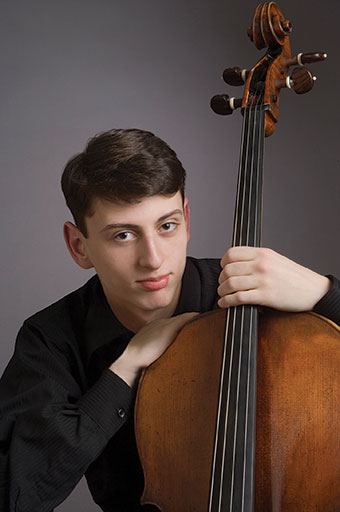Tchaikovsky Gold Medalist Comes to Buffalo
by Jan Jezioro

Armenian cellist Narek Hakhnazaryan at Nichols School
You have to hand it the volunteers who put on the long-running Ramsi P. Tick subscription series. The Tick series has managed to consistently bring top of the line classical soloists and ensembles to Buffalo over the course of the past twelve seasons. It continues that tradition with its final concert of this season on Tuesday May 15 at 7:30pm in the Flickinger Performing Arts Center at Nichols School on Amherst Street in Buffalo, featuring the Western New York debut of Armenian cellist Narek Hakhnazaryan, the Gold Medal Winner of the XIV International Tchaikovsky Competition. While another Tchaikovsky gold medalist, American pianist Van Cliburn, has been a frequent performer in Buffalo, local appearances by other Tchaikovsky competition medalists have been rare.
Armenian cellist Narek Hakhnazaryan’s uniquely poetic playing propelled him to the First Prize and Gold Medal at the 2011 International Tchaikovsky Competition in Moscow. Hailed as a “seasoned star” in the Washington Post review of his Kennedy Center debut, Mr. Hakhnazaryan’s 2011-2012 season features his first concerto appearance at Lincoln Center’s Alice Tully Hall, with the Orchestra of St. Luke’s under conductor Ryan McAdams, as well as performances with the London Symphony Orchestra and the Mariinsky Orchestra under Valery Gergiev, and it includes a five concert tour across Europe with the Moscow Philharmonic. Appearances with other international orchestras include the Verdi Orchestra in Milan, the Jerusalem Symphony, and the Tokyo Symphony at Suntory Hall in Japan.
Hakhnazaryan will also appear in recitals throughout America with the Boston Pops, the Pasadena Symphony and the Naples Philharmonic under Jorge Mester, and he has been invited to perform this year in Europe at the Verbier Festival in Switzerland, the Beethoven Festival in Poland and the Tivoli Festival in Denmark.
As a chamber musician, Mr. Hakhnazaryan will perform with the Boston Chamber Music Society and he has performed at Ravinia’s Steans Institute, in the Caramoor Festival’s “Rising Stars” series, and at the Young Concert Artists Festival at Chanel’s Nexus Hall in Tokyo. As First Prize winner in the 2008 Young Concert Artists International Auditions, Hakahnazaryan made his New York debut in the Young Concert Artists Series at Carnegie’s Zankel Hall, sponsored by the Jerome L. Greene Foundation, and in Washington, DC at the Kennedy Center, both to critical acclaim. Scholarships from the Rostropovich Russian Performing Arts Fund brought him concert appearances in Russia, Greece, Turkey, the UK and Canada. His other prizes include First Prize in the 2006 Aram Khachaturian International Competition in Armenia and First Place in the 2006 Johansen International Competition for Young String Players.
Hakhnazaryan was born in 1988 in Yerevan, Armenia, into a family of musicians—his father is a violinist and his mother is a pianist. His early studies were at the Sayat-Nova School of Music in Yerevan with Zareh Sarkisyan and at the age of 12, Hakhnazaryan began studies at the Moscow Conservatory with Alexey Seleznyov. Working with Laurence Lesser, he received an Artist Diploma from the New England Conservatory of Music in 2011. Hakhnazaryan plays a 1698 Tecchler cello, on loan from Valentine Saarmaa, granddaughter of the renowned luthier Jacques Francais.
Hakhnazaryan will be joined by his accompanist, pianist Noreen Cassidy-Polera, for a wide-ranging program that includes Schubert’s Sonata for Arpeggione in A minor, D. 821—a work now played almost exclusively by violists and cellists. The arpeggione was invented in1824 by the respected Viennese guitar maker Johann Georg Stauffer. The instrument—a kind of enlarged guitar that could be bowed, cello-style, due to an altered fingerboard—was by no means a success, and within a few years of its birth it had for all intents and purposes suffered extinction, but Schubert’s work for the instrument lives on as a favorite of cellists everywhere.
Cesar Franck composed his extremely popular Sonata for in A for Violin and Piano, but the dynamically dramatic work touched a nerve among many different instrumental performers, and one of the most successful transcriptions of the work was for cello and piano.
György Ligeti wrote his two-movement Sonata for Solo Cello from 1948 to 1953, when the Soviet thumb of oppression pressed heavily on his native Hungary. The first movement achieves the effect of a dialogue by having the cello alternate passages in different playing styles and is close to the more conservative music of Kodály. The second movement resembles the style of the late Bartók, especially the music of the Sonata for Violin Solo and Music for Strings, Percussion, and Celesta.
Hakhnazaryan will then send the audience off into the night with some more familiar works, including Chopin’s Introduction and Polonaise Brilliante, and Tchaikovsky’s Nocturne and Pezzo Capriccioso Op.62.
For tickets and more information, call 759-4778 or visit www.ramsitick.com.
blog comments powered by Disqus|
Issue Navigation> Issue Index > v11n19 (Best of Buffalo Issue, week of Thursday, May 10) > Tchaikovsky Gold Medalist Comes to Buffalo This Week's Issue • Artvoice Daily • Artvoice TV • Events Calendar • Classifieds |









 Current Issue
Current Issue